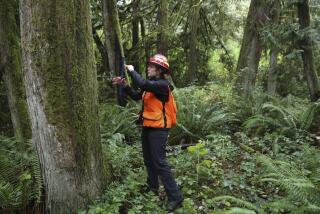Northwest’s Outlook Is Good Despite Downturn : Economy: Banner years for aerospace giant Boeing, diversification and growing Asian trade have stabilized the region.
- Share via
SEATTLE — He has no job and no money for rent, but carpenter Reuben Soto still believes the Northwest’s economy is tops in the nation.
Trouble is, he’s right.
In the late 1980s, the Northwest became the jewel of the U.S. economy, sparkling atop charts of economic growth and livability. The region still outshines the gloomy national economy, but that’s not saying much. As Reuben Soto discovered firsthand, the great Northwest boom is fading.
He came from Virginia last summer, a 35-year-old bachelor looking for work and a fresh start in life. He had heard times were good around Seattle and, sure enough, things started out well. Soto landed a carpentry job and rented a small apartment.
But then Seattle’s hot housing market cooled and construction slowed. Soto was laid off in November. He has yet to find another job.
“I’m going through some rough times now,” he said. “But I know it will get better. This is still a land of opportunity.”
He is not the only optimist in town. Many economists say the Northwest, though slowing down, is likely to escape the worst of a widespread downturn. A newly diversified economy, growing Asian trade, and banner years for aerospace giant Boeing have stabilized the region, once infamous for sliding to the bottom of national recessions.
“We’re not going to be immune to what’s happening elsewhere,” said John W. Mitchell, chief economist for U.S. Bancorp in Portland, Ore. “But you’re still talking about the strongest region in the country.”
Indeed, the strong growth of recent years has put the Northwest on solid footing to face economic challenges:
* Measured by employment, the region far exceeded average U.S. growth in the year ending October. Employment in Washington, Oregon and Idaho combined grew at twice the national rate. Add Nevada and Utah, the nation’s fastest-growing states, and regional employment grew 3.8%, nearly triple the 1.3% U.S. rate.
* All five Northwestern states last year were among the nation’s top 10 in growth of residents’ personal income.
* In Washington, the Boeing Co. nearly doubled its work force between 1983 and 1990. With more than 100,000 workers, the airplane maker now accounts directly or indirectly for one of every six Washington jobs.
* In Idaho, Oregon and Utah, diversification featuring high-tech electronics and computer industries has evened out the ups and downs of formerly resource-based economies. “Our growth has been broad-based,” said Michael Ferguson, Idaho’s chief economist. “We’ve got the good fortune of having the right product mix.”
So much for the good news. If 1990 culminated several years of heady Northwestern growth, it also was when the region started pulling in its horns.
In Washington, Boeing finished its hiring binge. The company is still a strong stabilizing force--it has orders for jets it won’t deliver until after the turn of the century--but the impetus behind Seattle’s population boom is gone.
The housing market has responded accordingly. In 1989, Seattle had the nation’s fastest-rising home prices. By the end of 1990, home prices were stagnant, and houses sat on the market for months. New construction fell off sharply.
State economists declared in November that Washington had entered a mild recession. They predicted that the state would lose 10,000 jobs by June, a 0.5% drop in total employment, then resume growing slowly.
Idaho’s rapid growth will slow considerably during the next three years, Ferguson said.
Perhaps the most worrisome Northwestern state is Oregon, where more than 30% of factory jobs depend on the beleaguered timber industry. A nationwide housing slump has reduced demand for timber, and logging restrictions aimed at protecting the threatened spotted owl are shrinking supplies. State economists predict that 5,400 timber jobs will disappear in 1991.
“The forest industry is Oregon’s Achilles’ heel,” said Michael J. Parks, editor of Marple’s Business Newsletter in Seattle.
Economists say such negative factors are cooling the Northwest’s hot growth down to a lukewarm prosperity.
“Our economy will behave and grow more like the rest of the country,” predicted Douglas Pedersen, economist at Security Pacific Bank Washington. “We’ll be growing faster than the national average, but the margin will be a little thinner.”
That is still attractive to regions mired in recession. But the Northwest formula may be hard to match elsewhere.
Some economists believe this region’s fortune hinges on “industries of the future” such as software and biotechnology, which benefit more from worker satisfaction than closeness to markets or raw materials.
Such “footloose” industries are lured by the Northwest’s fabled natural beauty and high quality of life, not by tax breaks or other government incentives, said U.S. Bancorp’s Mitchell.
“Oregon, Washington and Idaho have three totally different tax structures, but they’re all growing,” Mitchell said. “It’s not policy. We’re just lucky.”
More to Read
Inside the business of entertainment
The Wide Shot brings you news, analysis and insights on everything from streaming wars to production — and what it all means for the future.
You may occasionally receive promotional content from the Los Angeles Times.










